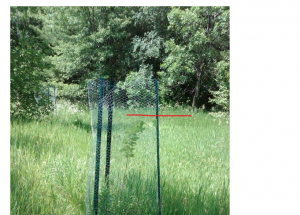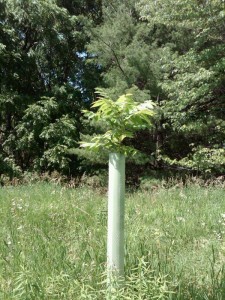I sometimes visit online discussion boards and chat rooms at sportsman’s web sites where Tree Tubes are being discussed.
One growing trend seems to be using the tree tubes to grow seedling trees past the deer, removing the tree tube, staking the tree, then using the tree tube to start another seedling. This technique has its risks, but it has advantages as well and is a completely legitimate practice if done properly. The risks of course are exposing the newly established sapling to rodent damage and buck rub. The advantage of course is cost: You can establish several trees with a single tree tube.
The idea of removing tree tubes after the seedlings emerge but before they are fully established reminded me of a debate that’s been going on in treeshelter circles for years: Do tree tubes provide growth benefits after the tree emerges, or does its function shift from a “protective growth chamber” to simply offering bark protection and trunk support?
As it turns out I have a unique – though decidedly imperfect – opportunity to test this question.
Last year, at the invitation of a teacher at my son’s grade school, I placed 4ft tree tubes over a hackberry seedling and a black walnut seedling growing in a natural area on the school grounds. I have no idea how old these seedlings were at the time. Both were volunteers that had been browsed by deer. Both were about 2ft tall. And both very quickly emerged from the tree tubes. At one point the hackberry’s growth could be measure in inches per day.
Early this spring I got a call from the group that manages the natural area. Based on the recommendation of a nursery from whom they purchase plant material (and who clearly knows very little about treeshelters) they wanted to remove the tree tube from the hackberry and replace with a chicken wire cage supporting by three T-posts. They said that the tree tube can stay on the black walnut sapling.

This hackberry grew 3 feet last year in a tree tube. It has not grown at all this year in a wire mesh cage.
You can see the problems right away: The cage protects from rabbits but not from mice and voles. There’s no good way to protect the hackberry from herbicide spray, or weed up to the trunk.
I literally don’t think it has grown at all so far this year.

This black walnut emerged from its tree tube last year, and has continued to grow rapidly this year.
The black walnut, on the other hand, has picked up where it left off last year: growing rapidly. I can think of two reasons for this: First, there are still leaves inside the tube, benefiting from the low-stress growth conditions. Second, the tube is allowing the tree to sway in the wind but is limiting the degree of bending. As a result the tree is channeling more of its growth energy into height growth.
This is not exactly what you’d call a statistically significant trial: Two trees, of unknown age, and of completely different species.
But it is interesting that the hackberry, which grew much faster up and out of the tree tube than the black walnut did last year, and slowed to a complete stand-still as soon as the tree tube was removed.
Again, removing & reusing tree tubes is a completely legitimate way to lessen the cost of using tree tubes, as long as you understand the risks and take steps to reduce them (of course replacing a tree tube with about 15 linear feet of 6 foot chicken wire and 3 steel T-posts doesn’t exactly reduce the cost!).
But it does appear – not just based on this puny little ad-hoc trial but on my 22 years of experience – that removing tree tubes shortly after the trees emerge also has a cost in terms of lost growth that should be factored into your considerations.
